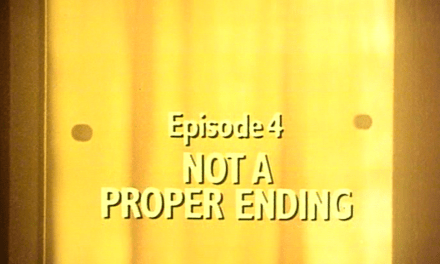One of the challenges of returning to my parents’ for the weekend (as I write, the bank holiday is looming) is the inevitable evening trawl for something watchable on television via such channels as Drama or ITV3. When we finally settle on something mutually acceptable like Poirot, One Foot in the Grave or Lovejoy, I will wearily point out that the aspect ratio on their widescreen television set is incorrect, with the result that David Suchet, Richard Wilson or Ian McShane have spontaneously gained a stone or so in weight through being unceremoniously stretched from their original 4:3 (also known as 1.33:1) aspect, in order to fully occupy the 16:9 (or 1.77:1) screen. The latter has become the standard for television receivers in recent years (and, indeed, for HDTV broadcasts), but it means that watching ‘old’ TV (which I do a lot of, both in terms of broadcasts and DVD/BluRay) on a modern widescreen set means having vertical black bars on either side of the picture – assuming that one wishes to enjoy the mise-en-scene in its original intended form (as, indeed, I do). To my father, this represents ‘wasting’ each side of the screen – and that’s not what he’s paid good money for.
This is a not uncommon phenomenon, alas. On my MA course several years ago, one of my fellow students opted for the 16:9 ratio when screening a Frank Capra clip, claiming that he couldn’t stand people who watched films in the wrong aspect. To him it was a film, and therefore needed to be widescreen. Everyone was too polite to point out that the movie in question was made in the 1930s (this was, after all, a higher degree course on the history of visual media), and so should have been watched in the Academy ratio (1.375:1, but as near as dammit to 1.33:1). Even if Capra had made his best work in widescreen, the ratio would probably have been 2.66:1 (original Cinemascope), 2.20:1 (Todd-AO) or 1.50:1 (VistaVision) – and not 16:9, which only came into popular use as a compromise home viewing ratio between 4:3 and 2.39:1 (the aspect used for modern CinemaScope).
Although widescreen sets first became available in the late 90s, it wasn’t until the 2000s that broadcasters took note and began incorporating this framing into production and broadcast. 14:9 was seen as a sound starting point, as this was an acceptable ratio for both 4:3 sets (on which it would be seen with thin black horizontal bars) and 16:9 sets (thin black side bars). In order to trace the chronological development of widescreen television, one need look no further than the unstoppable crime drama juggernaut of Silent Witness, which presents the ideal case study. The programme began production in 1996, when 4:3 reigned supreme. It then weathered the interim transition to 14:9 in the 2000s, before settling on its current 16:9 format. When watching a repeat on a modern widescreen set, it is possible to gauge how old the episode is from whether there are thick vertical black bars at the sides of the picture (4:3), rather thinner lines (14:9), or none at all (which means it’s 16:9, and comparatively recent).
Fascinating, isn’t it? No? Well, maybe I am a bit of an aspect ratio freak, but it genuinely irks me to see an old television programme or film being stretched unnecessarily in order to ‘make the most’ of a modern TV’s ample rectangular screen. It’s almost as heinous as pan and scan, the much despised (among cinema buffs) method formerly utilised for VHS and some terrestrial broadcasts by which widescreen films would be selectively cropped or re-framed in order to fit snugly onto 4:3 sets. Each of these bastardisations results in viewers not seeing the image that the programme/film makers intended, and for me the elongation of old programmes is a clear case of more being less.
The most straightforward way of ensuring correct viewing is to select ‘original’ on your TV’s aspect ratio menu. If this works, you’ll notice the frame size expanding when the adverts (which are now all made in widescreen) begin, and reducing again when the ‘old’ episode resumes. However, what the set recognises as ‘original’ is dependent on the signal being transmitted by the broadcaster, and I have occasionally come across channels which have already decided that an archive programme should be viewed in 16:9 – which means one must manually select 4:3 for the duration of said programme, and then remember to change it back to ‘original’ again afterwards.
Most annoying.
These issues have been much on my mind recently, as I am considering the purchase of a new television set. I already own a 32-inch widescreen which is only a couple of years old, but after staying recently with a friend in possession of an impressive 55 inches, I suddenly feel rather inadequate. This sentiment was reinforced when I took a peek at the TV Licensing Authority’s 2013 Telescope report, which only regarded sets of 33 inches or over as ‘jumbo’.
It seems I am large, but not super-large.
However, as a wise man once said, it’s not what you’ve got, it’s where you stick it. When I was living in a tiny studio flat, sitting just a few feet from the screen, 32 inches were more than adequate for my viewing needs. However, I am now in a more sizeable, rectangular apartment, and my armchair is positioned over eight feet from the TV. According to Rtings TV size to distance calculator, I therefore now require a 55 inch set in order to optimise my viewing experience (it’s something to do with pixels, apparently; they certainly sound as though they know what they’re talking about). Check it out for yourself; I guarantee you’ll discover that you need a much bigger TV than you thought.
Alternatively, you could just move the sofa closer.
Size is a separate issue from ratio, but what occurs to me is that watching a 4:3 programme on a 32 inch 16:9 set (height 15.7 inches, width 27.9 inches) means I have been getting roughly the equivalent experience of watching on an old 26 inch 4:3 set (height 15.6 inches, width 20.8 inches). Watching an ‘old’ programme on a 55 inch widescreen set (should I choose to splash out on one) would provide me with more or less the same picture I would have got on a 34 inch 4:3 set.
This sounds ample, but then again, if I’m so hell-bent on experiencing archive TV programmes ‘as they were’ at the time of broadcast, surely I should also consider whether such a sizeable set would have been available for TV programmes made in earlier decades? During a recent module I spent much time reminding my students that TV sets were not always the mammoth beasts they have become today. I had specifically requested a lecture room with the smallest viewing screen possible, in order to replicate the ‘televisual’ experience as closely as possible, but even this was monstrously vast compared to the screens on which viewers would have been watching in the 1950s (when they would have ranged from 7 or 9 to 12 or possibly 14 inches, sometimes as a tiny part of a huge walnut ‘cabinet’) or 60s, by which time a 24 inch set would have been regarded as an enviable luxury (as referenced in the Kinks B-side ‘Mr Pleasant’). The ideal, I suppose, would be to maintain a collection of old TV sets, from various periods and of various sizes, so that programmes could be viewed in circumstances as close to the original broadcasts as possible – but this would probably not be regarded as the best use of university resources, and I can’t imagine the AHRC splashing out on a funded project.
And I certainly wouldn’t be able to fit them all into my flat.
Although bigger is usually assumed to be better, and (as Telescope points out) jumbo sized sets had rocketed to 53% of total sales by 2012 (as compared with just 1% in 2001),[1] the news last year that overall sales of TV sets in the UK had fallen for the first time ever, and the various predictions regarding an imminent explosion in tablet sales (currently used by more than one in three in Britain), mean that small might once again become beautiful. What impact this will have on the production both of television sets and television programmes remains to be seen, but it’s an aspect (see what I did there?) I intend to pursue in the near future. In the meantime, I’m happy to supersize my set for the purposes of home viewing.
To return, however, to my opening theme (and at the risk of preaching to the converted), I strongly urge all my colleagues out there in television studies land to check their home (and, indeed, their university screening rooms’) aspect ratios at the earliest opportunity.
Make it a priority, and remember: original is best!
Dr Richard Hewett is Lecturer in Media Theory at the University of Salford’s School of Arts and Media. He has contributed to The Journal of British Cinema and Television, The Historical Journal of Film, Radio and Television, Critical Studies in Television and Adaptation. His book, The Changing Spaces of Television Acting, will be published by Manchester University Press in 2016. Full details can be found here.
[1] The 2014 report, however, reclassifies ‘jumbo’ screens as 43 inches and above, and these made up just 16% of sales in 2013.




